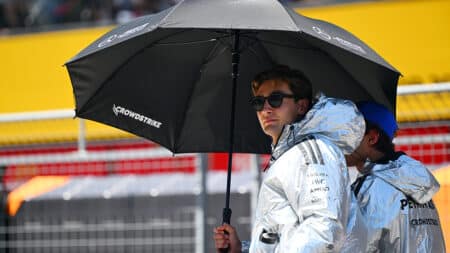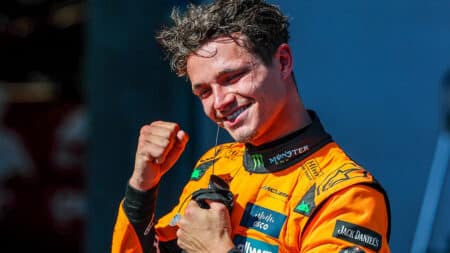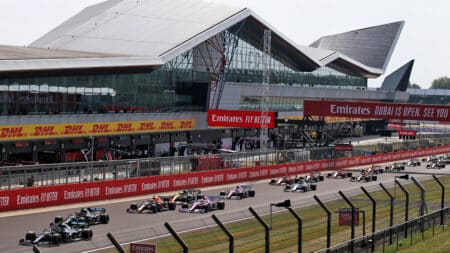
2025 is F1’s most polite title battle ever – Up/Down in Austria
Describing this year's championship race as a 'battle' might be slightly over-egging it, writes James Elson
In configuring the new MP4-30 more along the lines of Red Bull, new aero chief Peter Prodromou – ex of Red Bull – is attempting to drag McLaren back onto the rails it veered off two years ago. In the back story behind that is much of what characterises McLaren as the neurotic entity it is.
When analysing the performance of the various cars, the most illuminating part of the season invariably comes towards the end. That’s when I get to sit down with the various technical directors and have them explain ‘why’ things worked out the way they did from their perspective. By that stage of the year, with the competitive picture essentially set, they are much less secretive than now – the time when the cars are launched.
However, because the regulations of 2015 have remained largely unchanged – new nosebox rules aside – a lot of what we see in the designs of the latest machines can be informed by what we learned last year.

McLaren’s technical director Tim Goss last year highlighted the challenge of the aerodynamic regulations that came into force along with the hybrid engine formula. “Getting front end downforce was going to be quite challenging because the proximity of the front wing endplate to the tyre was quite penalising and the biggest challenge aerodynamically was to recover some sensible flow physics around the front end of the car.”
The narrower span front wing, with its extremities half way across the width of the tyre rather than flush with its sidewall, meant that generating the front downforce-enhancing vortices where they needed to be was now much tougher than before. These circular currents of air, created by the convergence of two or more streams coming together, are used as downforce boosters by modern aerodynamicists. Position a clockwise rotating one in the right part of the car (just ahead of the sidepod) and a counter-rotating one above or below it, with a small gap between them, and they each accelerate the speed of the other. In the process, the gap between them sucks in the air around it and in doing so pulls the airflow back over the front wing harder, increasing downforce. What these vortices also tend to do is pull the downforce-damaging choppy wake from the front wheels outwards, away from being sucked beneath the floor – where it would interrupt the flow to the diffuser.
These contra-rotating vortices have been a major preoccupation in F1 aerodynamics since at least 2007 and are formed by the meeting of the airflow that is 1) guided around the tyres by the wing endplates, 2) that coming off the angle of the wing as its geometry changes to form the FIA-designated aerodynamically ‘neutral section’ in the wing’s centre and 3) by flow coming off the various vanes or ‘flow conditioners’ on the wing’s underside and those aft of the wing.
Getting all those flows to meet up at the right place for the right effect became much more difficult when the wing endplate was no longer flush with the tyre sidewall. Trying to direct that flow around the outside of the tyre from only half-way across the tyre’s width meant that particular flow was nowhere near as robust as before.

But recovering front downforce wasn’t the only challenge. At the rear, blowing exhausts had been banished, as had the lower beam wing that connected up the flow coming off the diffuser with that of the rear wing – and the wing itself was narrower. Goss explained the thinking that in the conception of last year’s car led McLaren to prioritise rear downforce over front.
“We recognised there was going to be significant increase in torque and getting a fast car was going to be about getting a secure rear end to the driver and allowing them to deliver as much of that torque to the road as we could. We felt we absolutely had to secure a stable rear end, that the losses there created by the regulations and the greater demands placed there by the engine demanded a systematic solution. The loss of front downforce we felt was just going to be a matter of re-iterating the almost infinite number of ways you can change the surfaces to generate the vortices you want – and that we’d get there with development. So the systematic solution favoured the rear. That is why we went with a high nose, relative to these regs.
“With a low nose, if you drop it low over the FIA neutral section of the wing you drive that section of the wing harder and generate front end. The downside of that is you generate losses that travel back down the car and penalise the mid and rear part of the car. Instead we took the high nose route. It helped reduce the losses hitting the mid part of car and helped us get the rear end back to something sensible.”
So the MP4-29, as well as struggling to get those vortices to pull the flow harder over the wing did not have the compensating help of a diffuser effect created by narrowly shading the wing with the nose underside. “And as it turned out the front end of the car remained a real battleground,” said Goss. “It was all about detail design and although we made progress with it, that remained the main limitation of the car.”

The rear end of the car, fed by the flow through the generous gap between nose and front wing, was aerodynamically super-strong, especially when bolstered by the ‘mushroom’ blockers across the rear suspension. Aerodynamically, they mimicked the banned beam wing in linking up the flow between diffuser exit and rear wing, though at significantly more cost in drag.
Hearing Goss explain the attention to detail and exacting processes involved in creating those blockers gives an insight into why McLaren seems occasionally to trip up on its own cleverness, to lose sight of the wood for the trees. “The novel rear suspension layout was about recovering the seal rear downforce that we’d lost from rear lower mainplane. So we positioned suspension legs along the trailing edge of diffuser. You are restricted quite severely what shape those legs can be by regulation. The chord of suspension has to be symmetrical and you’re only allowed +/-5 deg of incidence when what you’d really like to do as an aerodynamicist is put a wing profile there. What we had to do was devise a shape that acted like an aerodynamic wing that satisfied the regulations.
“A lot of effort and detail went into getting that shape right. They might look quite crude but in reality they work as a cascade with the diffuser. Then you have suspension legs where the flow is attached to curvature at back of the leg. That produces a huge amount of up-wash in that area and allows us to drive the diffuser much harder and – importantly – to drive the rear wing harder. With the loss of the support of the rear lower main plane all teams have had to back off on rear wings; they can’t carry the same amount of camber or trailing edge departure angle. If you look at our rear wing – especially that which came mid-season – and compare it to others you’ll see it’s probably got the most camber and departure angle. We can do that and keep it stable and attached because we’ve got the rear suspension elements below it.
“It was challenging to get a lot of the other fundamentals on the rear suspension to work once you’ve put two of the legs in places that are compromised in terms of suspension kinematics and compliance. So it’s quite a difficult and exciting engineering exercise to get that to work mechanically and not to throw away too much mechanical performance that we were getting. Kinematically we knew where we wanted to go with it and that dictated where we were going to place some of the suspension links. There were issues to resolve in terms of compliance – the stiffness under lateral and acceleration load – how the uprights and tyres move and effectively steer themselves in a minor way, but we resolved those. Because we’d moved the legs into strange positions you end up with different behaviour of wheel and tyres, mostly under braking. On the dyno we’d see where the issues were and recovering was mainly about getting stiffness back into the rear crash structure and transmission.”

It was an innovative solution, it brought a big increase in rear downforce and the many challenges its creation presented were met. But ultimately, it was McLaren’s vast resources pointed in the wrong direction. The big aero challenge of the new formula turned out not to be more rear downforce, but in balancing some of that with decent front downforce. With the same engine as the Mercedes W05 (albeit for some of the year significantly down on horsepower because of not being on the fuel around which it was designed) the MP4-29 qualified an average of 1.4sec slower.
As the MP4-29 was the second consecutive aerodynamically below-par McLaren, huge changes were made this time last year to the aero department. In a necessarily brutal process, it was extensively re-staffed at three different levels of seniority. Heading up the new aero group is Peter Prodromou, formerly Adrian Newey’s number two – first at McLaren and latterly at Red Bull. In configuring the MP4-30 he has drawn heavily from last year’s Red Bull RB10. Like that car, it has a narrow gap between nose and front wing, the coke bottle profile of its bodywork behind the cockpit is incredibly tight, the big central cooling exit at the rear looks very familiar and the general contours of its bodywork and sidepod are such that with a change of livery it could easily be parked in the Red Bull garage without anyone noticing anything amiss.
Removing its rear bodywork would however reveal what Ron Dennis describes as a jewel-like Honda power unit, with the compressor at the front just like Mercedes, allowing the plumbing to be minimised and keeping those sidepods compact. What is not yet known is how it compares on power with the established engines and how far Honda has got with fully understanding the trade-off between mechanical and electrical power and therefore fuel efficiency.
But just as it’s typically McLaren to have veered off the rails chasing rainbows, so it would be equally characteristic for it to have configured an exceptionally fast and successful racing car after two mediocre ones.

Describing this year's championship race as a 'battle' might be slightly over-egging it, writes James Elson

You had to read between the lines at the 2025 Austrian Grand Prix as George Russell dropped hints over about his dissatisfaction, and F1 sent a message to FIA president Mohammed Ben Sulayem

From zero to hero: in a pacy McLaren, at one of his favourite F1 circuits, Lando Norris picked himself up from a disastrous Canadian race to reign supreme in the 2025 Austrian Grand Prix

Full F1 schedule for the year, including the next F1 race of 2025: the British Grand Prix at Silverstone, the whole calendar and circuit guides for the 24-race Formula 1 season